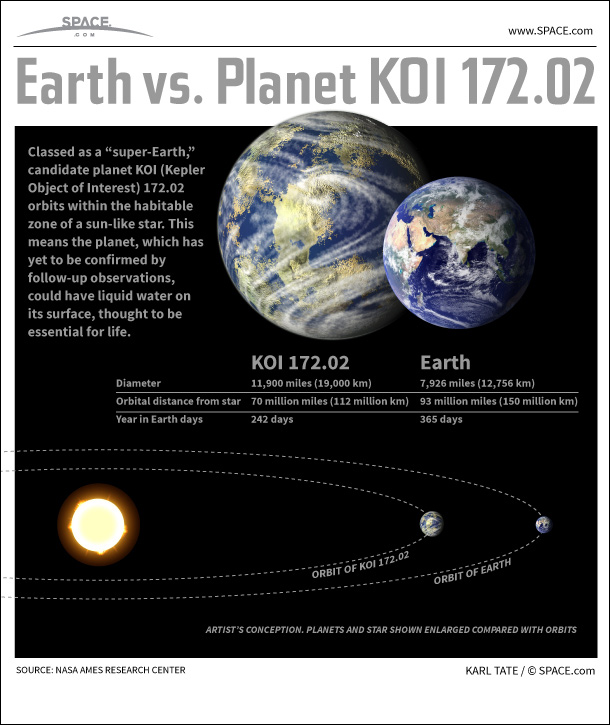Most Earth-like Exoplanet Discovery Explained (Infographic)

Classed as a “super-Earth,” candidate planet KOI (Kepler Object of Interest) 172.02 orbits within the habitable zone of a sun-like star. This means the planet, which has yet to be confirmed by follow-up observations, could have liquid water on its surface, thought to be essential for life.
KOI 172.02 is about 1.5 times the diameter of Earth. The planet orbits its star at a distance of 0.75 astronomical units, or about three-fourths of the distance from the Earth to the sun. The exoplanet takes about 242 Earth days to orbit its star.
Launched in 2009, the Kepler space telescope orbits the sun every 371 days. As it travels, Kepler keeps itself pointed at a single patch of sky. Sensors monitor the brightness of 150,000 stars simultaneously, looking for telltale drops in intensity that could indicate orbiting planets.
At the heart of the telescope is an array of 42 camera sensors specifically designed to detect planets passing in front of their stars
Kepler’s planet search is conducted in a narrow wedge-shaped volume of space that stretches out ahead of us as we orbit the galaxy. Stars in the search volume are therefore at about the same distance from the center of the galaxy as the Earth.
- 9 Exoplanets That Could Host Alien Life
- 17 Billion Earths in the Milky Way (Infographic)
- Kepler Reveals Lots of Planets: Some Habitable?
Breaking space news, the latest updates on rocket launches, skywatching events and more!

Karl's association with Space.com goes back to 2000, when he was hired to produce interactive Flash graphics. From 2010 to 2016, Karl worked as an infographics specialist across all editorial properties of Purch (formerly known as TechMediaNetwork). Before joining Space.com, Karl spent 11 years at the New York headquarters of The Associated Press, creating news graphics for use around the world in newspapers and on the web. He has a degree in graphic design from Louisiana State University and now works as a freelance graphic designer in New York City.
